Friday, September 30, 2005
A false hiatus? No, time for an overhaul.
It's fair to say I've outgrown Blogger, which I have to say for what it allows you to do is truly a great service. It's becoming clear that I'll have to look towards moving away from it and setting up a dedicated site or something... but if it's on a dedicated site, there's quite a bit more I want to do.
It's all something I'll be looking into. As they say, I'll be back.
Queries, offers, brickbats, etc... you can reach me on Head-Fi Private Messaging as 'bangraman'.
(by the way, I am far from the only person on the Internet with that handle. I was beginning to get tired of questions about clearly other 'bangramen')
Thursday, September 29, 2005
Boil from the Past
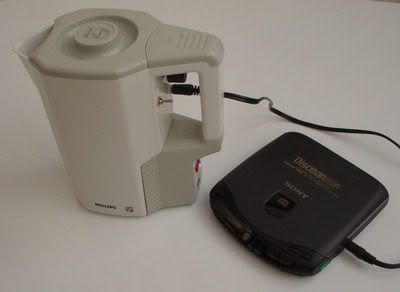
A META42 headphone amp was built inside it. The lid acted as a battery holder mount, so I could change cells by opening the kettle. The volume knob is just visible in the picture. I thought about adding a DC jack where the original cable existed, but never got around to it.
It was great to unearth on planes and long train journeys. The weird looks it got was highly amusing.
Wednesday, September 21, 2005
What the fall-off sounds like
The music is from approximately 4:00 to 4:30 of the track "The Missed Symphony" of Infected Mushroom's Classical Mushroom (this is an amazon link) in 192K MP3. Well worth buying by the way if you have any interest in electronica. I've chosen this music because the effects of the falloff are most apparent in heavily beat-based music like this.
Both exerpts were recorded directly out of the X5 from the headphone socket (40 volume, all FX off, no EQ) and the Line Out socket on the subpack, going into a soundcard with a line-level input impedance.
Here's sample 1
Here's sample 2
Guess the Line Out with bass falloff (no need to post your guesses here though). It should be obvious... at least it is on the headphones/amps I use, but whether it bothers you is something according to your own tastes.
If you can't hear a difference, it's probably because your headphones /speakers have a boosted mid-bass response which is obscuring the differences in the lower bass regions, or that your phones / speakers aren't able to depict lower bass (either issue is not uncommon on lower-end consumer gear). In which case the falloff effect doesn't really disadvantage you in a practical context.
As you can hear either way though, the falloff-afflicted output doesn't sound noticeably more 'terrible' as some might whinge (too much time in RMAA, not enough time listening). But clearly it needs to be fixed because an EQ boost can't compensate for it, because all that would happen is that the EQ will boost up to the point of the falloff curve.
The track excerpt is not used with permission, although arguably speaking it falls within fair use. If anyone concerned has a problem with it, please drop me a private message at Head-Fi and I'll upload something else.
PS. The first sample is the line out.
Saturday, September 17, 2005
Amping the iAudio X5
The Meier-Audio Porta Corda II (now replaced by the Porta Corda III) is a generally high-performance portable amplifier. Because some elements of the signal passing through can be noticeably changed and sort of cleaned up by an amp, applying good amping to an underperforming player can sometimes have a bigger felt impact than amplifying a good one... although of course, amping a good player is the best solution!
When I had the iAudio M3, the X5's predecessor, I didn't really bother amping it as I felt the subpack assembly (a 'dongle' that fits without any means of retention on the underside of the M3) was too delicate to use for portable amping purposes. The X5 sticks to exactly the same arrangement and I still feel it's too delicate. However, I tried amping it this time around.

The X5 and subpack. Darn, that carry bag was dusty... :D

The X5 subpack connector and the iPod dock connector.
The problem I encountered is something that's already discussed a lot on the iAudio related forums. There is a bass fall-off, like the iPod's headphone out... only on the X5, you get a fall-off from both the headphone out and the Line Out.
The X5 headphone out's bass fall-off and other factors contribute to a sonic performance on aggregate on a par with, or maybe just slightly better than, the iPod Photo... which correspondingly has a lower audio performance than the monochrome iPods. So it's not bad at all, although it could be better.
However the Line Out fall-off is something that I've rarely seen on modern players. According to my measurements at the headphone side of the Porta Corda II amplifier (input impedance: 3.6kohms), it is registering a 4.5db falloff at 47hz, with a 1db falloff starting at 130hz. Plugging in the Porta Corda II amp into the headphone socket of the X5 however, turning the volume up to max and turning off all effects, I'm rewarded by a ruler-flat frequency response and significantly decreased distortion compared to the subpack line out... a very audible difference, I ought to say.
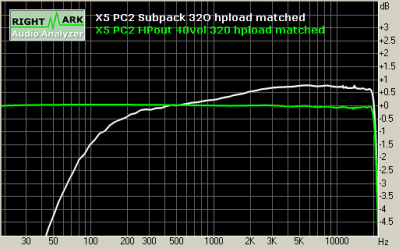
Both measurements were made at the headphone socket of the Porta Corda
at nominal listening levels, with a 32 ohm headphone in the chain.
Now, there are plusses and minuses to this. Firstly, as I said the subpack design hasn't changed, and in my opinion it is too fragile to use portably with a Line Out cable plugged in on a regular basis. So you could argue that there's no point in portable amping using the subpack... and this is true to an extent. However, using the subpack allows the use of a remote, which is very handy while using a portable amp.
The same falloff by the way happens with the optional dock.
Having said all that, even though the measurement looks pretty dire the Line Out is not a dead loss... it's still perfectly listenable as it were. Apart from the bass loss, there's nothing particularly crappy about the sound. It's just not as good as it should be given the performance of the headphone out when used in the same way. It just looks like lazy design or a component mis-spec that wasn't corrected for a long time (the X5 sub-pack uses the same PCB as the M3 sub-pack... so I'm assuming the components are the same, and the M3 had the same problem).
I must admit on the basis of problems like this, I'm having second thoughts about getting rid of the iRiver H320. The H320 definitely doesn't work as well in daily use and is a a bit of a huge tank in comparison, but it seems to be sonically and physically better sorted out. Sigh...
Click here to go to a later post about what the falloff sounds like
Wednesday, September 14, 2005
Loading the iAudio X5.
I've not got further in the lack of album-based browsing when your folders are sorted by artists, but I have made some headway in getting music on and off the player in a managed way.
For the music management software, I've been using j.River Media Center. There are some counterintuitive aspects to this program, but on the whole it is easy to use, and more importantly extremely powerful as a management tool. In fact it's a lot more than that, since it can act as a Home Theater front end as well but it's strengths are in media management. Because you can rig it up (in fact, the default setting) to look like iTunes, there is no major culture shock in moving to it. I'd suggest you try the 30-day trial edition to get a feel of this package. It's one of the few that I thought really worth paying for when there's something like iTunes available for free.
One of the things that Media Center doesn't do is to auto-launch when you dock the iAudio. So I solved this by using Quickfind's Autoplay Repair, a tool which allows you to edit the Autoplay entries. I just set up Media Center to launch in there.
Next, I wanted to sync the podcasts I subscribe to. iPodder dumps your podcasts arranged by subfolders into whatever folder you nominate, so I just set up SyncToy as an Autoplay entry and set up the X5 to sync with the podcast folder.
Now, I'm quite pleased with the overall set-up.
iAudio X5, iPod 4G Photo and Sony HD5 without backlight

All three players in subdued daylight with backlight off.
Sunday, September 11, 2005
Sony MDR-J20 vs Sennheiser PX 10 : low cost ‘sports phones’
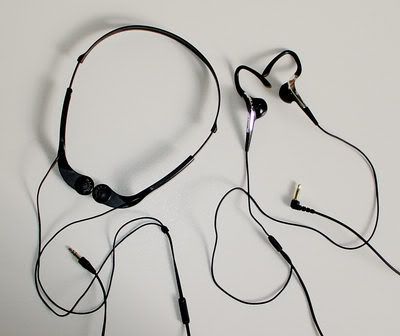
PX10 on the left, MDR-J20 on the right.
Both the J20 and the PX10 are ‘partially in the ear phones’. These take a regular earphone speaker and turns it 90 degrees so that part of the speaker assembly is almost inside the ear canal at an oblique angle when worn. Pioneered on the ‘Turbo’ Sony sports earphones more than a decade ago, this increases the stability of fit for active types, and also delivers more bass into the ear than loosely coupled regular earphones.
DESIGN/FIT
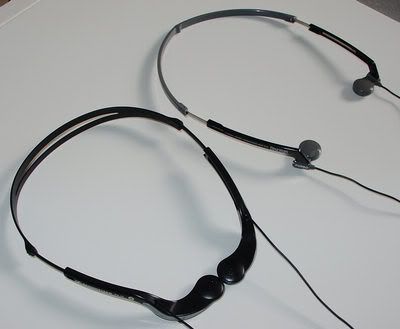
The PX10 is a headbanded ‘partially in the ear’phone, very much like the original ‘Turbo’ phones. The engineering is however in some ways a retrograde step to the ‘Turbo’. The lightweight all-plastic construction doesn’t provide enough ‘spring’ in the headband to exert sufficient pressure to give a solidly secure fit and contributes to a feeling of floppy fragility, and it doesn’t fold. Lookswise, it’s rather more sculptured than the ‘Turbo’ bringing the look up to date. And finally, it adds an additional feature which will undoubtedly come in handy for runners: An MX500-style sliding volume control just below the symmetrical Y-split in the cable. The slider control is however pretty on/off. There’s not a smooth transition in volume, rather a series of uneven steps of large cuts. I would expect that the precise behaviour of the volume control will vary in individual examples due to the cheapness of the sliding potentiometer. The 3.5mm mini plug is nickel plated.
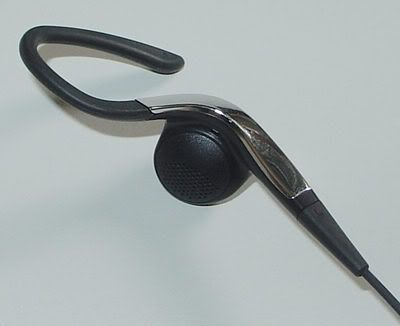
Closeup of the MDR-J20 (Left side).
The Sony MDR-J20 is a slightly more imaginative take on the original ‘Turbo’. Instead of a headband, it uses earhooks to retain the phones in the ears. So it is compact and definitely easier to stow than the PX10. The look is very contemporary and well executed. They manage, thanks to the shape and the silver accent to be pretty discreet but a definite ‘style point’. The hooks successfully hold the J20 in place during most activities… but it is easier to pull these out than the PX10, due to the lack of a headband and also the shape of the part that goes inside the ear. The J20 adopts Sony’s common asymmetrical cable arrangement, with the cable for the right ear going behind the neck, joining the left cable on that side. The super-low-profile right angled 3.5mm plug is gold plated. The phone is available in silver/black as above and also white.
Both are subjectively equally comfortable to wear due to their light weight and the way they sit fairly unobtrusively in the ear. However the PX10 with a higher cable attachment point and the Y-split does allow the cable to be potentially more intrusive. The J20 works with bicycle helmets and other protective headgear, while the PX10 can do to a degree but is not comfortable when used in such a situation.
SOUND
As with practically any earphone of this type, fit does control sound to a degree, although as said before with much less variability than regular style earphones. When hung lightly on the ear these give the best sound clarity. When pushed into the ear canal for a more secure fit, both phones become murkier (for the obvious reason that the start of the ear canal would ‘plug up’ the holes where the sound comes out of). The Sony’s exhibited far more potential degredation in this respect. For the purposes of sound quality measurement, the evaluations were made by sitting the phones at a point where they were securely fitting and would remain so, but exhibited the least impeded sound. Both phones had sufficiently high efficiency to be powered by the ~5mw/channel output of the Sony HD5. Neither provides isolation as such, but the Sony when pushed into the ear gave a more pronounced blocking of outside noise.
Both are more secure in fit than regular earphones, and both do provide a more balanced sound on the move. If you just want background music and just want something unobtrusive that stays in place while jogging or whatever, the Sony MDR-J20 is not a bad choice, especially as you can just wad it up for storage unlike the PX10. Subjectively speaking, the Sony also looks smarter on the head. However the Sennheiser is nearly as unobtrusive in actual use and a clearly better sounding item. A case of horses for courses...
PRODUCT LINKS:
Sennheiser PX10
Sony MDR-J20 (silver)
Tuesday, September 06, 2005
Sony HD5, iPod 4G Photo and iAudio X5 battery tests.
I finally decided to run a 'sort of real-life' battery test of three players: The iPod Photo, the Sony NW-HD5 and the iAudio X5 (the standard X5, not the L).
The test is pretty simple. Charge it up, leave for 48 hours, then play back my test MP3 library which has a wide range of songs, the lowest being 128Kbits and the highest being 320. All effects off, all EQ off. The volume is adjusted to slightly louder than I would normally listen to on a pair of Sony MDR-V700DJ headphones. I also simulate some fiddling by 'using' (i.e. navigating without changing playback order) the player for about 10 seconds at a time for 10 times throughout the testing period. The backlight is enabled for at least 10 seconds after key presses on all players.
With a 21-hour stint until the batteries gave out, the HD5's amazing claimed battery life of 40 hours therefore is less amazing here, although it has still a major lead. It also had an advantage in the test... having no quick wake and no onboard clock, when you leave it there is no battery drain. Given those factors, a rather disappointing performance.
The iAudio X5 surprised with a conservative documented battery life, managing 14.5 hours when the claimed life was 14.
The iPod? It's an iPod, the 'up to 15 hour' life had to be a huge piece of fiction, right? Well... no. It turned in a 14.5-hour life in the test, identical to the iAudio. And this was the player most handicapped by the 48 hour leave test bit, because it wakes up immediately in normal use so doesn't actually switch itself off for a while.

Your real-life use will probably not match up to these examples and may be longer or shorter. It depends on the bitrate of the songs, how often you fiddle with the player, etc, but this test is a good indication of how these compare when on a level playing field. The other factor is the display. The Sony and iPod both have displays which are visible in daylight without the backlight (amazingly, the iPod's colour display is slightly clearer than the Sony HD5's monochrome display in daylight without the backlight) so in order to eke out more battery life, you can turn the backlight off if you're working / travelling in fairly brightly lit places. The iAudio has a display which is totally black without the backlight, so needs it on.
EDIT: 13th September 2005
As soon as I've ripped enough albums in ATRAC3+, I'll do the same test @ 192K on the HD5.